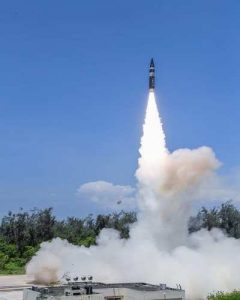Agni-P (Prime):

A new-generation nuclear-capable ballistic missile, Agni-P (Prime) was successfully test-fired by the Defence Research and Development Organisation (DRDO) from the Dr. A.P.J. Abdul Kalam island, Balasore, off the coast of Odisha.
- The ‘Agni Prime’ is the advanced version of the ‘Agni-1’ missile.
- The ‘Agni Prime’ is a short-range ballistic missile that will have a range of 1000 km to 1500 km and will have advanced features in agility and road mobility. It is a surface to a surface missile that can carry a payload of around 1,000 Kg or a nuclear warhead.
- The double stage missile will be lighter and much sleeker than its predecessor ‘Agni-1’.
- It is a canisterised missile. Canisterisation of missiles reduces the time required to launch the missile while improving its storage and mobility.
- The Agni class of missiles are the mainstay of India’s nuclear launch capability which also includes the Prithvi short-range ballistic missiles, submarine-launched ballistic missiles and fighter aircraft.
Submarine missiles:
- In the past few years, India has also operationalised its submarine-based nuclear launch capability, completing the nuclear triad.
- The DRDO, in January 2020, successfully test-fired a 3,500-km range submarine-launched ballistic missile, K-4, from a submerged pontoon off the Visakhapatnam coast.
- Once inducted, these missiles will be the mainstay of the Arihant class of indigenous ballistic missile nuclear submarines (SSBN) and will give India the stand-off capability to launch nuclear weapons submerged in Indian waters.
- INS Arihant, the only SSBN in service, is armed with K-15 missiles with a range of 750 km.




